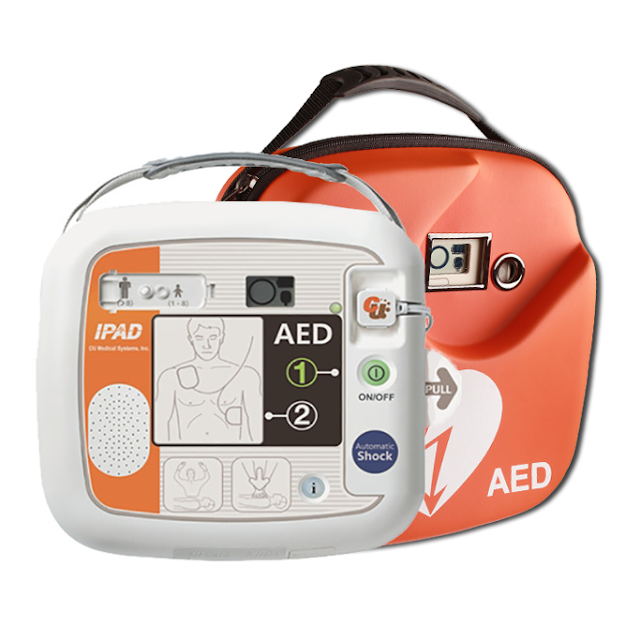Everything You Need To Know About Defibrillators
Safety Assessment
11:29 PM
0
It's no exaggeration that defibrillators are life-saving machines that have changed the way that sudden cardiac arrest is treated. As a leading cause of death in the UK, the NHS and other medical professions have put an emphasis on increasing the awareness of these medical machines and how they work.
With such a focus being placed on these machines it's worth knowing more about them. Which is why we are answering all of your defibrillator questions.
With such a focus being placed on these machines it's worth knowing more about them. Which is why we are answering all of your defibrillator questions.
What Is An AED?
AED stands for automatic external defibrillator, which is a small, portable device that is used to automatically supply a stock to that heart to restore it back to its natural rhythm.
When Should They Be Used?
A defibrillator should be used when someone is suffering from sudden cardiac arrest. When someone's heart enters fibrillation, it is important to act as soon as possible as every minute counts. AED's are designed to be this first response and keep a person alive until the emergency service arrive.
Who Can Use Defibrillators?
What makes AED's so special is that they can be used by anyone to resuscitate someone in need. It doesn't matter if you have no medical training or knowledge, as they are designed for those who haven't had prior defibrillator training.
AED stands for automatic external defibrillator, which is a small, portable device that is used to automatically supply a stock to that heart to restore it back to its natural rhythm.
When Should They Be Used?
A defibrillator should be used when someone is suffering from sudden cardiac arrest. When someone's heart enters fibrillation, it is important to act as soon as possible as every minute counts. AED's are designed to be this first response and keep a person alive until the emergency service arrive.
Who Can Use Defibrillators?
What makes AED's so special is that they can be used by anyone to resuscitate someone in need. It doesn't matter if you have no medical training or knowledge, as they are designed for those who haven't had prior defibrillator training.
How Do They Work?
Defibrillators work by providing the patient with an electronic shock that the heart needs in order to stop fibrillation. This is done by guiding the user step-by-step through the resuscitation process, using both vocal and visual instructions. This includes how and when to administrate CPR and providing a bespoke electronic shock that is delivered through defibrillator pads.
Do You Need To Be Trained To Use A AED?
As we mentioned before, because they are simple to use, anyone can utilise a defibrillator no matter if they have received prior medical training. However, to help users build confidence and save lives, a course can be utilised using a training AED.
Are They Safe?
Defibrillators will never provide a shock to anyone who doesn't require treatment. They are programmed to monitor patients heartbeats and only act if a shock is required, which is why they are extremely safe to use. This is also one of the reasons why almost anyone can operate the equipment.
Defibrillators work by providing the patient with an electronic shock that the heart needs in order to stop fibrillation. This is done by guiding the user step-by-step through the resuscitation process, using both vocal and visual instructions. This includes how and when to administrate CPR and providing a bespoke electronic shock that is delivered through defibrillator pads.
Do You Need To Be Trained To Use A AED?
As we mentioned before, because they are simple to use, anyone can utilise a defibrillator no matter if they have received prior medical training. However, to help users build confidence and save lives, a course can be utilised using a training AED.
Are They Safe?
Defibrillators will never provide a shock to anyone who doesn't require treatment. They are programmed to monitor patients heartbeats and only act if a shock is required, which is why they are extremely safe to use. This is also one of the reasons why almost anyone can operate the equipment.
Do Defibrillators Need A Power Source?
No, they don't. AED's are powered using a battery which has enough energy to provide the required treatment. If used or if they have remained unused for a period of time, the defibrillator's battery will need changing. Here at Risk Assessment Products, we cater for all of your needs which is why you can find a range of defibrillators and replacement batteries on our website.
Where Can They be found?
Defibrillators are portable and lightweight making them perfect to be placed in hospitals, medical centres or public places. As sudden cardiac arrest can strike anywhere, these machines have been designed to be placed wherever they may be needed.
No, they don't. AED's are powered using a battery which has enough energy to provide the required treatment. If used or if they have remained unused for a period of time, the defibrillator's battery will need changing. Here at Risk Assessment Products, we cater for all of your needs which is why you can find a range of defibrillators and replacement batteries on our website.
Where Can They be found?
Defibrillators are portable and lightweight making them perfect to be placed in hospitals, medical centres or public places. As sudden cardiac arrest can strike anywhere, these machines have been designed to be placed wherever they may be needed.





